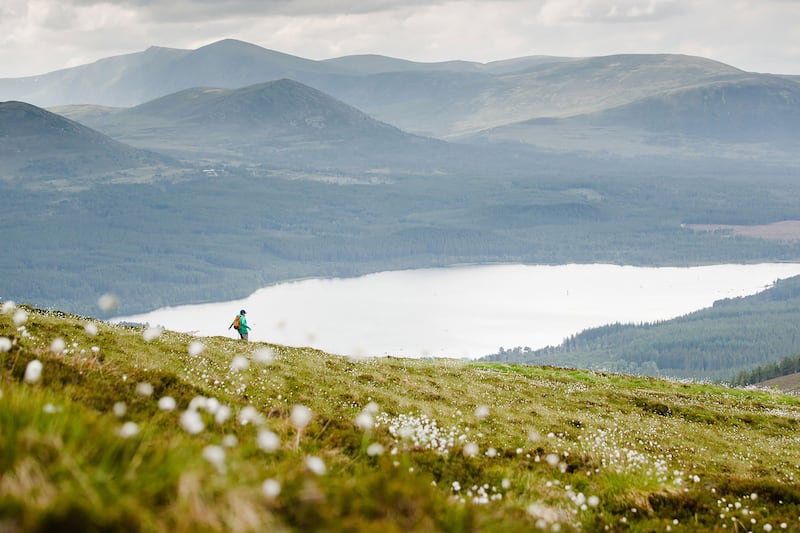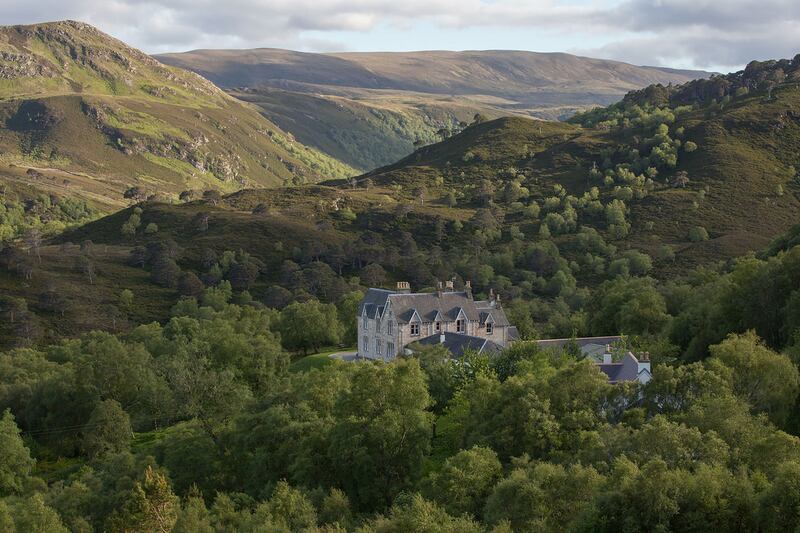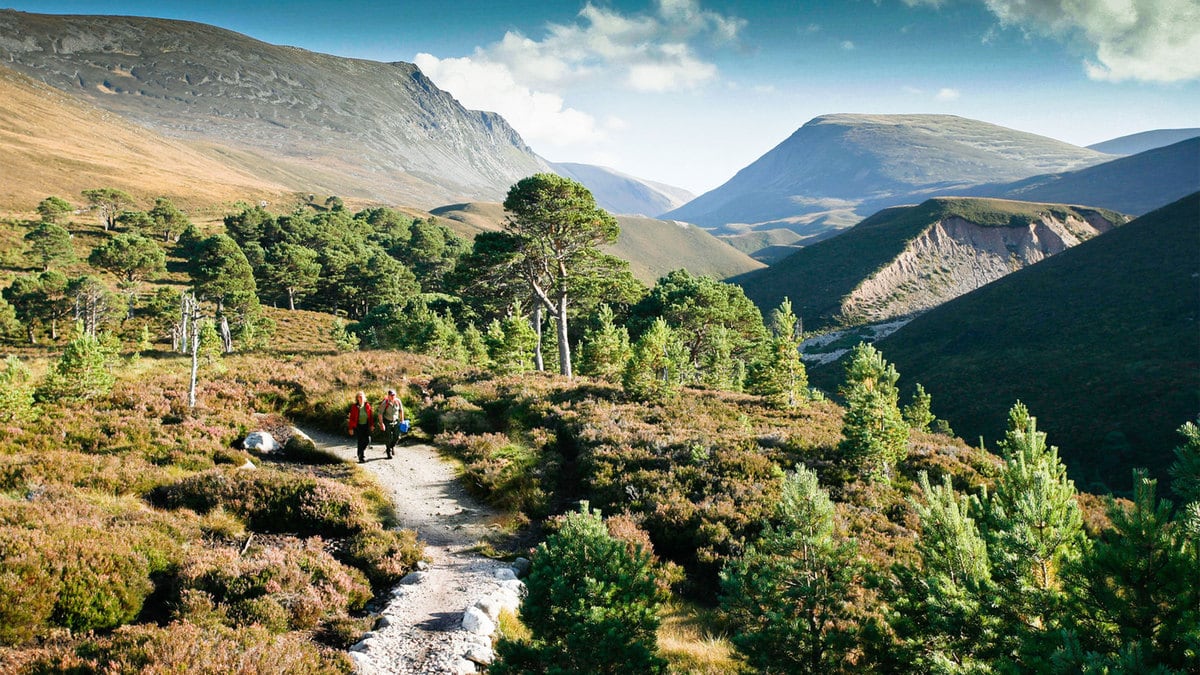In Cairngorms National Park in the Scottish Highlands, purple heather cloaks the hillsides and sloping mountain peaks crest and plunge like waves towards the horizon. It’s a vast, godly landscape that will leave any nature lover awestruck with its magnitude. Yet, where only a scattered patchwork of Scots pine—Scotland’s national tree—now exists, was once a far more lush, biodiverse region: the Caledonian forest. “People think of Scotland as wild but really, there’s not much wild left,” says Joe Mann, a guide with ecotourism company Wilderness Scotland, who leads hiking trips through the park.
Ancient Roman texts memorialize the woodland as a dark, foreboding wilderness called the Great Wood of Caledon, the name they bestowed on Scotland, meaning “wooded heights.” The truth of when this forest actually existed and why it disappeared is murky, but only 1-to-2 percent of what it was at its zenith remains.
Now, a group of visionary conservationists and ecotourism companies are working to revive the landscape through rewilding. The functional, whole-ecosystem approach to nature restoration involves the removal of invasive species, reforestation, and a reintroduction of endemic flora and fauna. “The aim of rewilding is to achieve self-regulating, complex ecosystems with a high level of biodiversity,” says Denmark-based ecologist Jens-Christian Svenning, founder of the Center for Biodiversity Dynamics in a Changing World. The work is happening across the Highlands, and in 2021, the Scottish Rewilding Alliance, a group of nonprofits and businesses, petitioned for Scotland to be the world’s first “rewilding nation”.
ADVERTISEMENT

What conservationists should be aiming to restore the Highlands to, though, and what caused the land degradation in the first place is complex. The skeletal arms of preserved Scots pine, rising spectral from peat bogs, as well as pollen analysis, tells us that the region was much greener before large-scale agriculture, when grazing animals, namely sheep and cattle, were introduced and didn’t allow for much to grow.
However, most experts agree that the impenetrable wilderness described by the ancient Romans—most notably by the historian Tacitus—largely disappeared around 2,000 years before the Romans ever set foot in Scotland, so its demise can’t be blamed entirely on human activity. “Around 2000 B.C., a major climatic deterioration happened, and it got extremely wet, causing most of the pines to drown,” says Richard Tipping, a paleoecologist whose work focuses on Scotland’s environmental archaeology. “Roman authors would paint the landscape in very forbidding terms because they wanted to exaggerate Roman invasions,” explains Tipping.
The Highlands the ancient Romans would have marched across was likely desolate peat bog punctuated by slivers of forest. Whatever remnants of the woods existed in Roman times, however, never fully recovered and modern agriculture compounded the issue. “The constant light grazing suppressed the trees after they died from climate, so they didn’t really have a chance to come back,” says Tipping. That’s what rewilding conservationists, including Cairngorms Connect, the UK’s largest rewilding project based in Cairngorms National Park, are hoping to help with.
Ecotourism businesses are stepping in to support these initiatives, giving travelers a look at the rewilding projects, which is crucial in raising awareness. By removing invasive species, reintroducing endemic flora and fauna, and restoring natural waterways and peatlands, the park is showing new signs of life. On Wilderness Scotland’s High Points of the Cairngorms trip, guides like Mann lead trekkers through this newly flourishing landscape. Clambering up hillsides blanketed with spongy, cinnamon-colored sphagnum moss and crimson devil’s matchstick lichen, hikers can spot species that have recently returned to the park. Golden eagles wheel through the sky, endangered red squirrels scurry up Scots pine, and elusive pine martens dart through the understory. Where half a century ago the mountainsides might have been completely bare, delicate green saplings are harbingers of hope.

This fall, the company is working with one of their charity partners, Trees for Life, a nonprofit dedicated to nature restoration in the Highlands, on a new adventure. The five-day journey will take hikers through hills aflame under autumn’s spell, and end at Trees for Life’s Dundreggan estate. There, they’ll explore the rewilded trails that thread through the area, and in 2023 travelers will also be able to experience the new Dundreggan Rewilding Center on the same trip. “If we are going to encourage rewilding to happen, we need more of a nature-based economy, and that’s absolutely about tourism,” says Steve Micklewright, CEO of Trees for Life. “We want to show that as we rewild, we create more jobs, not less,” adds Micklewright.
The idea for the center, which will include a 40-room lodge, came on the heels of several decades of interest in volunteering from visitors, and will educate guests on the nonprofit’s work through immersive experiences and exhibits. Travelers will also have the option to head out on the surrounding leafy trails or get their hands dirty planting trees. For Wilderness Scotland, the collaboration was about helping guests understand nature in a deeper way. “Hopefully they’ll go for a walk in the hills near their home and have a greater appreciation for nature,” says Wilderness Scotland co-founder Paul Easto.
Farther north in the Highlands, Scottish Rewilding Alliance member Alladale Wilderness Reserve has built their tourism model around restoring nature on a former hunting estate. A converted Victorian mansion and three secluded cottages give guests access to one of the most remote parts of the Highlands, where mist settles in the folds of the hills, and the only noise is the tide of birdsong at dawn and dusk. Founder Paul Lister has dedicated the reserve’s 23,000 acres to reforestation and planted over one million trees.
“Rewilding is taking pressure off the landscape for extractive uses and putting nature at the center of what we’re doing,” says Lister. “At the same time, we’re creating revenue for the work through ecotourism.” On a hike along the rushing Alladale River, which veins through the reserve, travelers can spot some of the same animals that have been reintroduced in the Cairngorms, including red squirrels. An overland adventure that ends with a picnic lunch on the riverbank includes a stop at an on-site sanctuary for the threatened Scottish wildcat, a conservation breeding project Alladale is working on with the Royal Zoological Association of Scotland.
“We’re also working to restore bogs because peatlands store much more carbon than trees,” says reserve manager Innes MacNeill, who guides many of the lodge’s excursions. (Peatlands store twice as much carbon as the world’s forests.) “We’re looking to improve on what is and move forward, not go back to what once was,” adds MacNeill.

This is sage advice most experts agree should be heeded by conservationists. Considering how long ago the Caledonian forest was a rich, vast woodland of Scots pine, and how much climatic events played a role in its demise, it’s crucial not to cling to a romanticized idea of the Great Wood of Caledon as described by the ancient Romans, especially in our rapidly changing climate. “We are already bound for quite significant, further climate change that will push ecosystems away from any kind of recent historical baseline,” says Svenning.
At a time when trees like sycamore, beech, and elm—previously associated with southern England—could now happily grow in Scotland, the focus should be on the evolution of the Highlands and establishing a biodiverse ecosystem that can sustain itself for generations to come. This edifying vision is what Scotland’s rewilding stakeholders aim to instill in visitors. “I hope people come away with hope for a wilder future,” says Micklewright.




